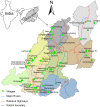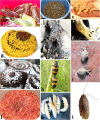Entomotherapy: a study of medicinal insects of seven ethnic groups in Nagaland, North-East India
- PMID: 33752694
- PMCID: PMC7986042
- DOI: 10.1186/s13002-021-00444-1
Entomotherapy: a study of medicinal insects of seven ethnic groups in Nagaland, North-East India
Abstract
Background: The ethnic communities in Nagaland have kept a close relationship with nature since time immemorial and have traditionally used different kinds of insects and their products as folk medicine to treat a variety of human ills and diseases. The present study was conducted to record the entomotherapeutic practices of seven different ethnic groups of Nagaland.
Method: Documentation is based on semi-structured questionnaires and group discussions with a total of 370 informants. The data collected were analysed using fidelity level (FL) and informant consensus factor (ICF).
Results: Fifty species of medicinal insects belonging to 28 families and 11 orders were identified in connection with treatments of at least 50 human ailments, of which the most frequently cited were coughs, gastritis, rheumatoid arthritis, stomach ache and wound healing. Mylabris sp. showed the highest fidelity level (FL) of 100% for its therapeutic property as a dermatologic agent, while the informant consensus factor (ICF) ranged from 0.66 to 1.00. The use of medicinal insects varies amongst the seven ethnic groups, suggesting that differences in cultures and geographic location can lead to the selection of specific insect species for specific medicinal purposes. The largest number of insect species appear to be used for treating gastrointestinal, dermatological and respiratory diseases.
Conclusion: The list of medicinal insect species, many of which are reported for the first time in the present study, suggests the presence of a considerable diversity of therapeutically important insect species in the region and elaborate folk medicinal knowledge of the local ethnic groups. This knowledge of insects not just as a food, but also as therapy is passed down verbally from generation to generation, but is in danger of being lost if not documented in a systematic way. Having stood the test of time, traditional folk medicinal knowledge and its contribution through entomotherapy should not be regarded as useless as it has the potential to lead to the development of novel drugs and treatment methods.
Keywords: Entomotherapy; Fidelity level; Informant consensus factor; Medicinal insects; Traditional knowledge.
Conflict of interest statement
The authors declare that they have no competing interests.
Figures








Similar articles
-
Practices of entomophagy and entomotherapy by members of the Nyishi and Galo tribes, two ethnic groups of the state of Arunachal Pradesh (North-East India).J Ethnobiol Ethnomed. 2011 Jan 14;7:5. doi: 10.1186/1746-4269-7-5. J Ethnobiol Ethnomed. 2011. PMID: 21235790 Free PMC article.
-
Healing from the wild: an ethnozoological exploration of animal-based medicine in Jhargram, West Bengal, India.J Ethnobiol Ethnomed. 2025 May 14;21(1):32. doi: 10.1186/s13002-025-00760-w. J Ethnobiol Ethnomed. 2025. PMID: 40369577 Free PMC article.
-
Indigenous knowledge of medicinal plants used by the Reang tribe of Tripura state of India.J Ethnopharmacol. 2014 Feb 27;152(1):135-41. doi: 10.1016/j.jep.2013.12.037. Epub 2014 Jan 7. J Ethnopharmacol. 2014. PMID: 24412549
-
Unravelling the potential of insects for medicinal purposes - A comprehensive review.Heliyon. 2023 Apr 29;9(5):e15938. doi: 10.1016/j.heliyon.2023.e15938. eCollection 2023 May. Heliyon. 2023. PMID: 37206028 Free PMC article. Review.
-
An overview on ethnobotanico-pharmacological studies carried out in Morocco, from 1991 to 2015: Systematic review (part 1).J Ethnopharmacol. 2021 Mar 1;267:113200. doi: 10.1016/j.jep.2020.113200. Epub 2020 Aug 1. J Ethnopharmacol. 2021. PMID: 32750461
Cited by
-
Rapid Diagnostic PCR Assay Method for Species Identification of Mantidis Ootheca (Sangpiaoxiao) Based on Cytochrom C Oxidase I (COI) Barcode Analysis.Int J Mol Sci. 2024 Sep 23;25(18):10224. doi: 10.3390/ijms251810224. Int J Mol Sci. 2024. PMID: 39337711 Free PMC article.
-
Sericulture and the edible-insect industry can help humanity survive: insects are more than just bugs, food, or feed.Food Sci Biotechnol. 2022 May 4;31(6):657-668. doi: 10.1007/s10068-022-01090-3. eCollection 2022 Jun. Food Sci Biotechnol. 2022. PMID: 35646418 Free PMC article. Review.
-
Edible Aquatic Insects: Diversities, Nutrition, and Safety.Foods. 2021 Dec 6;10(12):3033. doi: 10.3390/foods10123033. Foods. 2021. PMID: 34945584 Free PMC article. Review.
-
Integrative taxonomy of the genus Coridius Illiger, 1807 (Hemiptera: Heteroptera: Dinidoridae) reveals hidden diversity and three new species from North-East India.PLoS One. 2024 Jul 31;19(7):e0298176. doi: 10.1371/journal.pone.0298176. eCollection 2024. PLoS One. 2024. PMID: 39083554 Free PMC article.
-
Indigenous knowledge system associated with the uses of insects for therapeutic or medicinal purposes in two main provinces of Burkina Faso, West Africa.J Ethnobiol Ethnomed. 2022 Jul 5;18(1):50. doi: 10.1186/s13002-022-00547-3. J Ethnobiol Ethnomed. 2022. PMID: 35790988 Free PMC article.
References
-
- Alves RRN, Barboza RRD. The role of animals in human culture. In: RRN A, Albuquerque UP, editors. Ethnozoology Animals in our lives. London: Academic Press; 2018. pp. 277–301.
-
- Shelomi M. Why we still don’t eat insects: assessing entomophagy promotion through a diffusion of innovations framework. Trends Food Sci Technol. 2015;45:311–318. doi: 10.1016/j.tifs.2015.06.008. - DOI
MeSH terms
LinkOut - more resources
Full Text Sources
Other Literature Sources

